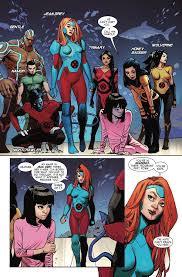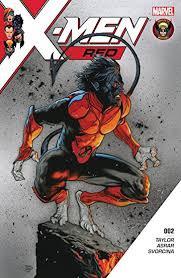Having fairly enjoyed the Phoenix Resurrection story (reviewed here), I was always going to be watching with interest to see what would now be done with the resurrected Jean Grey.
In truth, I’m probably a bigger fan now of the teeny-bopper, time-displaced Jean Grey we’ve been seeing for years: but, even so, someone like me – who’s firmly grounded in the X-Men books of the early 90s – has an innate attachment to our old Jean Grey.
So having her restored to the contemporary X-Men universe is rich with potential, even if the fact of having two Jean Greys in our contemporary landscape might be somewhat problematic.
X-Men Red is where we find the answers to that question of ‘Jean’s Back – What Now?’
While I questioned the addition of yet another X-Men title to the current list (we’ve already got X-Men Gold, X-Men Blue and Astonishing X-Men, and now a new incarnation of the Uncanny X-Men title as well), I can see the justification for creating a new book just purely to put to the resurrected Jean Grey front and center.
I was initially thinking it would’ve been better simply to incorporate Jean in to one of the existing titles, perhaps X-Men Gold in particular (a title that has been diminishing in quality and could use a boost).
But as X-Men Red progresses, the justification for this decision becomes more evident. And ‘The Hate Machine’ – and later, ‘Waging Peace’ (available as Volume 2 of X-Men: Red) – turns out to be not simple comic-book/fantasy fare, but a genuine exploration of real-world socio-political issues in our contemporary landscape, including the ‘post-truth’ world, conspiracy theory culture, false-flag conspiracies, hate propaganda, viral racism, and even something like Cambridge Analytica.
Jean’s support team seems at first like a mixed bag.
I was happy with Laura Kinney being there, and delighted to see Nightcrawler and Namor there right at the start of X-Men Red #1. Trinary, Honey Badger and Gentle were wild cards, however, and – as the series progresses – only Honey Badger was able to make much of an impression on me.

But this title is mostly centered on Jean: and, from the get-go, it is gratifying to see our old Jean Grey back in the action and trying to find her place in this new world she has emerged in.
This opening story arc of the X-Men Red title (‘The Hate Machine’) is undisguised social/political commentary on our current world. There’s no missing that – this is a story with an axe to grind and things to say. To some, that could be off-putting: but comic books have always probed and/or reflected the state of society (in subtle ways or in totally overt ways like last year’s Secret Empire), and so ‘The Hate Machine’ is firmly in the tradition.
What works about this, particularly in X-Men Red #1, is that this negative energy in society (the ‘hate’ that is being spread across the world) is not just a social commentary on our current state of affairs, but is tied potently to Jean Grey herself and her struggle to understand or come to terms with this new world she finds herself in.
That’s actually a very clever set-up. By taking someone who isn’t from this time-period, someone who remembers perhaps a more civil, less hateful world, and exposing her to this climate, it’s a very good premise for exploring these dynamics.
‘I’ve never felt the world so angry, so divided’, Jean thinks to herself, ‘I want to help’. And that, there, is the set-up for what this series is about.
It’s a good, powerful situation to put the newly-returned Jean Grey into. And Jean’s whole approach, as shown in X-Men Red #1, is really interesting. This book isn’t thinking small: she goes all over the world in her mission to ‘heal the world’ (okay, a bit cheesy), seeking support from various places – including, crucially, from Namor in Atlantis and T’Challa in Wakanda. There’s also a subtle Malala Yousafzai cameo in Pakistan, I think, which is a nice touch.
This climaxes in the United Nations, where Jean petitions the world leaders for mutants to be given representation in the UN. It’s a bold move and a really interesting direction. I really enjoyed all of this, both in the broad sense of what Jean is doing and in the smaller details (such as having Namor and T’Challa support her in the UN).
Unfortunately for Jean, she has been set up to look like the perpetrator in a false-flag conspiracy: outside the UN building, she is seen to kill the British Ambassador, thus throwing her whole plan into chaos and making her look like a mutant super-villain in front of the international leaders. We soon learn that it is Cassandra Nova who is behind the false-flag plot. It’s a sad and potent cliffhanger, concluding what is a genuinely interesting opening installment of this title.
There are also nice touches throughout: in particular, the Jean/Nightcrawler sequence where she shares her plans with him. This scene is poignant and it also nicely grounds us in a piece of classic X-Men mythos within the context of a story that is otherwise fairly new and bold.
My one quibble is that I think the artwork lacks punch or definition in some places – though the visual quality varies throughout the book.
That aside, X-Men Red #1 is a solid opener, establishing an interesting premise very well.
What’s also quite a clever move is not introducing all of the characters at once: Trinary and Gentle are shown at the beginning of X-Men Red #1 with the rest of the ‘team’, but don’t actually appear at all in that book. It’s in X-Men Red #2 that we get their backstories and see them brought into Jean’s situation.
X-Men Red #2 sees the fall-out from Cassandra Nova’s false-flag assassination for which Jean is being blamed by the world. Far from combating the ‘hate’ in the world, Jean has made it worse by having it look like a mutant has carried out an assassination at the UN.
One of the good things about this title is its international flavour. X-Men Red #2 starts with Jean and her team hiding out in Wakanda, granted asylum by T’Challa: but it then quickly shifts to India, where Jean has gone to extricate Trinary (a ‘technopath’) from her situation and recruit her into the group. This is a fun little heist/rescue story and it’s good to see a team coming together.

X-Men Red #3 continues the social commentary, with references to ‘anti mutant’ propaganda on the Internet, viral lies and half-truths being spread on social media and algorithms targeting people to feed into their biases and prejudices and stoke the hate.
There’s no question the writers are exploring the contemporary real-life climate and the ‘culture wars’, etc. At this point, mutants are almost a stand-in for real- world Muslims: although the ‘hate machine’ is probably speaking more broadly than that. What’s clear here is that masses of people are being targeted deliberately to embrace hate and xenophobia – and this is what Jean and co are up against.
On page 15 we also get an image of a torch-wielding, racist mob in Louisiana, which seems to be a reference to what happened in Charlottesville last year. Some people don’t like when comics try to speak too blatantly to contemporary politics or social issues, but I’m not one of those people – comics have every business exploring or reflecting real-world affairs and developments.
And X-Men Red is doing it pretty well.
Despite the serious themes and commentary, X-Men Red #3 has room for the fun stuff too. Gambit and Storm both joining the party in separate scenarios is a happy occurrence, we get to see Jean’s team riding a flying Sentinel into Wakanda (!), and there’s a lot more development for Trinary here. I really like Trinary’s power being the ability to read, communicate with and manipulate digital technology: I guess it’s really handy as a plot device, but it’s also just cool.
X-Men Red #4 reveals that an analytics firm (like the real-world Cambridge Analytica) are using everyone’s social media against them – using it to goad and amplify their biases and to use this to control social and political outcomes.
The hate is spreading and mutants are in the crosshairs. There is also something more specific causing the trouble: ‘sentinites’ or nano-tech based on Sentinel protocols, which infects people’s minds directly and causes them to act in certain ways.
Jean’s encounter/reunion with Storm in Wakanda is a highlight: the first time they’re meeting again after many years (of Jean being dead) is actually a confrontation between Jean and a mind-controlled Ororo who wants to destroy Wakanda. Having T’Challa feature in the story (naturally – it’s Wakanda) also helps things (and Jean’s “you miss so much when you’re dead” in response to T’Challa’s reference to having been married to Ororo is a great line).
But, deciding that their presence is a liability to Wakanda’s safety, Jean and co instead head to Atlantis to seek sanctuary with Namor.
Again, it’s good to see these different locations in the Marvel Universe being incorporated into this story (and it leads to some fun quips at Namor’s expense – Honey Badger’s “Abs-lantis” joke is pretty funny).
We also find Cassandra Nova going around the world and convincing different leaders why mutants are a threat and need to be dealt with (offering a ‘mutant detection device’ in the bargain). This is kind of interesting, as it’s a reverse image of what Jean was doing in the first installment – Nova is consolidating the hate while Jean was trying to combat it. It’s kind of twisted: but it sets up Nova and Jean as not just adversaries and mirror-opposites.
X-Men Red #5 plays out some of the consequences of Cassandra Nova’s manipulations, with mutants being rounded up and expelled from Poland.
This one is rather close to the mark in terms of real-world politics: this happens to be Poland, but the climate in any number of European countries today (Hungary being a strong example) is comparable to the fictionalised situation here, where xenophobia, mistrust and persecution are pushing people, even governments, to act in certain ways.
X-Men Red #5 is clearly speaking to the contemporary refugee crisis in Europe and the nationalist/xenophobic backlash.

Jean and her group – now including Gambit – ride “Trinary’s Sentinel” to the site of the trouble to protect the mutant refugees from the Polish Army. While some of the moralising here is perhaps a touch simplistic, it’s difficult for a writer to touch on a subject like this in comic-book form without moralising.
X-Men Red #6 sees the stakes raised, seeing Jean and co on a mission to try to steal the information that could clear Jean’s name and prove her innocent of killing the British Ambassador: only to find that Cassandra is at that moment launching an attack against Namor in Atlantis.
The plotting and pacing here is very effective, as Jean sends Gambit and co to carry out their heist while she works to use her powers to identify and locate the source of the hate and the conspiracy. The moment where she makes psychic contact with Cassandra is interesting, particularly the dialogue that unfolds between them, which now sees us touching on the contemporary business of ‘post-truth’ or post-fact perception and falsehoods.
When Jean threatens to fight Cassandra with ‘the truth’ and Cassandra says “no one cares about truth anymore”, it is clearly touching on contemporary paradigms and debates. This is no longer just a struggle between Jean and Cassandra or between conflicting ideologies or intentions, but a struggle between truth and falsehood itself and the battle between those two opposites for the minds of the general population.
It’s an interesting theme and one that, again, makes this series something more than simple comic-book fare, but something thematically very relevant.
The attack on Atlantis that dominates X-Men Red #7 is, visually, the most striking sequences of images in any of these books so far. I really cannot fathom why Namor doesn’t have his own monthly title – and why he hasn’t had one for such a long time. This installment is action-packed, the action split between two different unfolding situations – one in Atlantis, the other aboard a plane where Gambit’s team is trying to retrieve the data to clear Jean’s name.
Both missions are successful, and Jean is able to transmit the evidence across the world to explain that she was framed by Cassandra Nova – and to warn the viewing public about the ‘hate machine’ and what they are being subjected to without even realising it.
X-Men #8 has Jean, Trinary and co trying to fight Cassandra on a mental level to stop the sentinites invading various world locations, while Gambit, Storm and Nightcrawler locate Cassandra’s physical location in Genosha and go after her. There isn’t much to say about this installment, other than that it keeps everything moving fluidly and is filled with nice character work and interplay.
The one thing I found myself questioning is Trinary’s strategy of unleashing all of the ‘hate’ she has absorbed from the Internet over the years in order to overwhelm and stop the sentinites. I get it thematically (she refers to all the hateful things she’s absorbed from trolls, comments sections, etc, over the years), but in plot terms it’s just a weird, gimmicky thing that doesn’t necessarily make any sense.

What’s striking again about X-Men Red #9 is how good the character interplay is, ranging from poignant to cute or otherwise well-attuned to X-Men history. Whether it’s between Jean and Kurt, Jean and Ororo or between Laura, Gabby, Trinary and Gentle (the whole awkward scene of Gentle trying to ask Trinary out is a highlight – thanks to Laura and Gabby’s trolling), the way these characters are playing off each other is really enjoyable to read and X-Men Red may have somehow found the best character dynamics of any current X title.
On the more serious side, the sight of Cassandra Nova literally holding Rachel Grey on a leash like a dog and forcing her to attack Jean is pretty perverse and agitating – especially if you’re a big Rachel Grey fan like I am. Cassandra’s order – “go, kill your mother” – is pretty dark too. It’s actually really nice to see this Rachel/Jean reunion here and it actually proves to be a little poignant even.
Jean manages to convince Nova to let Rachel go in exchange for Jean’s surrender. The big reveal – the trick Jean plays here – is that she isn’t actually physically present in Genosha at all. Yes, it’s the Luke Skywalker maneuver from The Last Jedi – Jean is merely projecting a version of herself psychically to Cassandra’s location, while she’s actually safely far away with her team.
While it feels a touch questionable whether a psychic like Cassandra would fall for that, it is nevertheless a nice little reveal: and it’s ultimately good to see Jean outwitting her enemy like this.
Also, Jean’s brief diatribe to Nova at the end – about being afraid of other people’s compassion and good nature – is a much more effective comment on the ‘hate machine’ theme than the entirety of Trinary’s absorbing-all-the-hate-from-the-Internet thing in the previous issue.
Subtlety often works better than overt moralising when it comes to themes like this.
X-Men Red #10 sees things coming to a head. And the writing here continues to not only touch on contemporary current affairs and social issues, but also on ‘conspiracy theory’ culture.
As someone very well grounded in that conspiracy culture, I can recognise such references and influences whenever they appear. Just as this whole arc pretty much kicked off with a false-flag attack (Cassandra orchestrating the attack on the British Ambassador and making it look like Jean did it), we now have a fake digital recreation of Jean Grey addressing the world and essentially threatening a mutant war on humanity.
Thankfully, as the story shows us, not everyone is falling for it: some don’t believe the image of Jean Grey is genuine (just like so many analysts in the real world didn’t believe some of the Osama bin Laden videos were genuine).
X-Men Red #10 is a highlight of this run.
As the conflict between Jean and Cassandra really builds to its conclusion, the big hands start to get played: Cassandra has manipulated an entire military force into attacking Jean on Genosha by creating the false story (or, again, false-flag) of Jean having hijacked a bunch of passenger planes with human victims aboard. But Jean plays her big hands too: she calls on Tony Stark, who in turn brings the Avengers to Genosha to stand with Jean’s team.
Tony’s cameo is a fun surprise: but the arrival of the Avengers is actually a really nice moment, as is the arrival of Namor and his Atlantean army, both because it demonstrates how rich and interconnected the Marvel tapestry is and because it nicely demonstrates the solidarity between groups – with the likes of Captain America and Captain Marvel happy to come to the aid of Jean Grey when most of the world has swallowed the anti-mutant propaganda.

The other big twist here is when Jean whips out her Magneto helmet – informing Cassandra that she is now immune to his telepathic manipulations thanks to the helmet. It’s a very cool moment – and I think they missed a trick by not having an image of Jean holding the Magneto helmet as the front-cover image (how good would that have been?).
In fact, everyone on Jean’s side of the fight is revealed to have a Magneto helmet. I scratched my head at that for a moment: Jean and her immediate team having the helmets was ok, but when it was shown that Namor and his entire Atlantean army was also wearing the helmets, as were the Avengers, I was trying to work out where all of these Magneto helmets came from.
Were they mass produced? By who? And on such short notice? I suppose it’s possible Stark could’ve mass produced them for Jean – but that isn’t specified anywhere in the book.
On the other hand, it’s such a cool idea that I found myself unable to really maintain my cynicism.
X-Men Red #11 is where all this wraps up: and it is a touch anti-climatic as far as the action goes. But it makes up for that with its focus on the themes and the moral center of this entire storyline, in which case it ends on a strong note.
Fittingly enough, this all ends with Jean’s return to the United Nations General Assembly to address all the delegations. Here, the socio- political commentary that has underscored this entire run is nicely and meaningfully concluded, particularly with Jean’s speech about returning to a world “where intolerance is cheered, where ignorance is celebrated, where rumour is fact and fact is dismissed”.
The fact that Jean has been ‘dead’ for years and has only just recently returned to this timeline made her character the perfect premise from which to explore and challenged these contemporary themes and problems: and this is why it was so clever to do a storyline like this and to have her front-and-center of it.
The fate of Cassandra feels a little weak, though it’s perfectly understandable that Jean would show compassion towards her: she fills Cassandra’s mind with compassion and with the knowledge and understanding of all the harm she has done. For me it doesn’t feel like the comeuppance that Cassandra really deserves: but, in fairness, it’s meant to be more a reflection of Jean’s character – compassion and some form of poetic justice.
On the action side of things, the rest of the book unfolds as fairly standard comic-book super-heroing and race-against-the-clock stuff: but it does it very well.
The ingredient that sustains dynamism through this is the character interplay and the humour: pretty much all of the interplay here is golden, whether it’s between Gambit and Thor, Stark and Namor, Kurt and Gabby… or basically Gabby and everyone. Every character, including guest characters like the Avengers, are written really well – which is often not the case when guest characters cameo in other titles.
In all, X-Men Red #11 is a solid, thoroughly enjoyable finale to this long arc: and it also holds to the serious themes that have characterised this story from the beginning.
That’s about as good as you could hope for. A fitting finish to what has generally been a strong, engaging and enjoyable run.
And through all of it, I find myself loving the classic Jean Grey even more than I already did.
I also think this group of characters – with the possible exception of Nezhno/Gentle – has thrived together, including Trinary and especially Gabby/Honey-Badger. This whole run has reminded me a lot actually of the short-lived All-New Inhumans title from a couple of years ago (which I reviewed fully here and which I actually loved). But having Kurt there, and bringing in Storm, Gambit and Namor worked as a smart contingency plan in case the newer characters didn’t quite work.
I highly recommend X-Men Red #1 – 11 to any X-Men enthusiasts, and especially Jean Grey fans, of course. Actually, I recommend it to pretty much anyone who’s into Marvel Comics.
I generally don’t do number scores or ratings here, but this run would warrant at least a 9/10 in my reckoning. And it has been the best thing happening in the X-Men world for months, at the very least.




